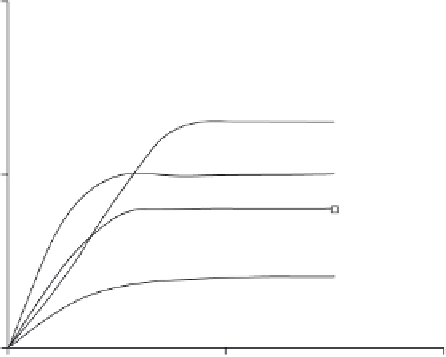Biomedical Engineering Reference
In-Depth Information
TABLE 14.4. Different States of Water in Monolithic PVA - MG s Prepared from Different
PVA Concentration
Free water
b)
, %
Bound water
c)
, %
PVA concentration in
reaction mixture, % w/v
Total water
a)
, %
DSC
Vapor ads.
DSC
Vapor ads.
3.5
95.6
91.8
90.7
3.8
4.9
5
94.7
89.6
88.0
5.1
6.7
8
94.4
88.0
84.9
6.4
9.5
Reproduced from [Plieva et al., 2006b] with permission.
a)
Total water content in cryoPVA was determined as difference between the swollen and dried
cryogel.
b)
Free water was determined as freezable water using DSC or as difference between total and
adsorbed water in water vapor adsorption experiments.
c)
Bound water was determined as the difference between total and free water when using DSC and
as the amount of water adsorbed in water vapor adsorption experiments.
40
20
0
0
4
8
Time, s
Figure 14.12.
Swelling kinetics of different MGs: pAAm (closed diamonds), PEG (open
triangles), dextran-MA (open squares) and PVA (closed triangles) after bringing dry samples
in contact with water. Swelling kinetics was performed as described elsewhere [Plieva et al.,
2005]. Reproduced from [Plieva et al., 2007a] with permission.
14.5.2 Characterization of Porous Structure Using
Different Microscopy Techniques
There are no common techniques for the analysis of porous structures of hydro-
philic materials. The most used technique for the analysis of pore size distribution
in a porous material is mercury porosimetry, but it is not that well adaptable for
the MGs, due to the soft and hydrophilic texture of these materials. Besides by
the method described above, the porous structure of the MGs was studied using
















Search WWH ::

Custom Search